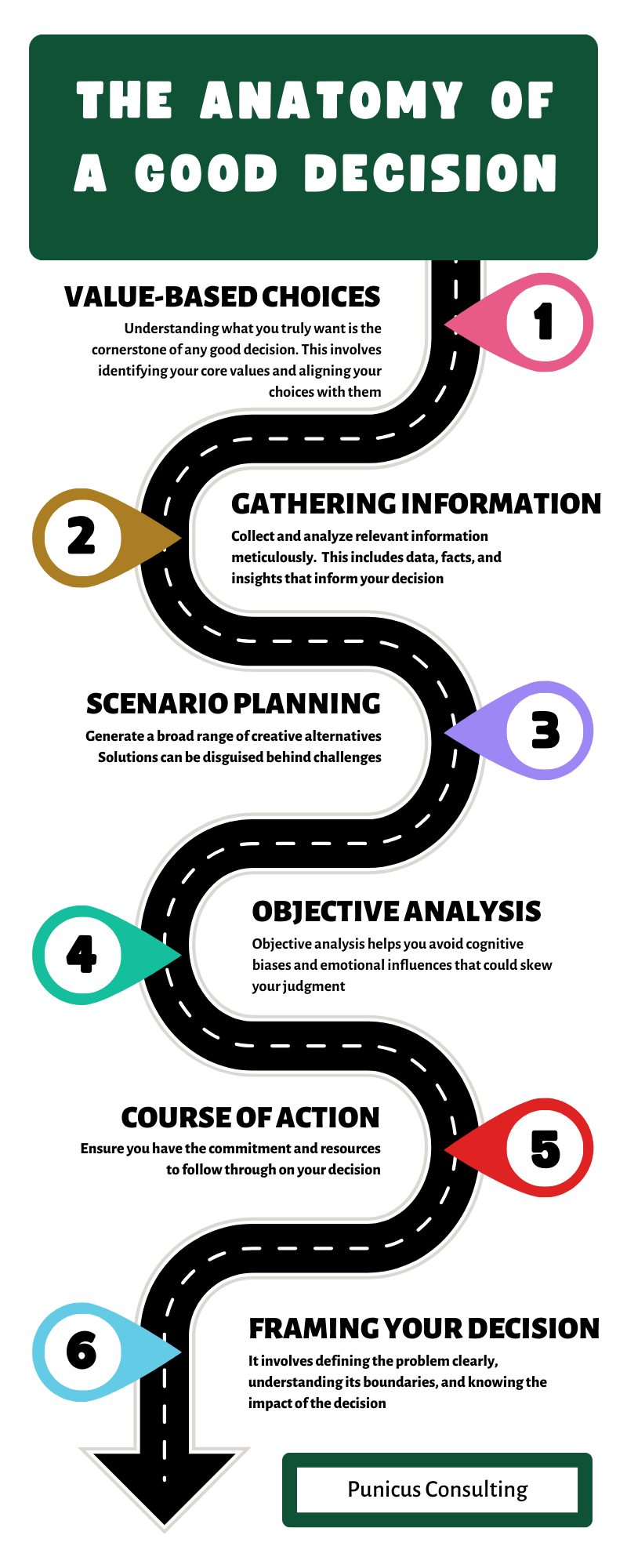The Anatomy of a Good Decision
In today's uncertain business environment, making well-informed decisions is crucial to driving success and innovation. From strategic boardroom deliberations to everyday operational choices, the quality of our decisions can make or break our plans. An aligned decision-making process is essential, as it ensures that each element is robust and well-considered, reinforcing the principle that a decision is only as strong as its weakest link.
Elements of a Good Decision
A good decision isn't just a spur-of-the-moment choice. It involves a structured approach, ensuring the decision makes sense and feels right. Here are the key elements that form the backbone of a sound decision:
1. Value-Based Choices: What Do I Want, and Why?
Understanding what you truly want is the cornerstone of any good decision. This involves identifying your core values and aligning your choices with them. Clear values guide you towards decisions that are congruent with your personal or organizational goals, providing a stable foundation for further deliberation.
2. Gathering Information: What Do I Need to Know and Where to Look?
Gathering relevant and accurate information is critical. Businesses must prioritize data-driven decision-making, ensuring choices are based on solid evidence rather than assumptions or incomplete data. This approach mitigates risks and enhances strategic planning.
3. Scenario Planning: What Are the Future Scenarios That Might Materialize?
Exploring future scenarios ensures you’re not confined to the obvious or the familiar. Innovation stems from exploring creative alternatives. By encouraging out-of-the-box thinking and brainstorming diverse options, businesses can uncover new opportunities and more effective solutions, fostering a culture of innovation.
4. Objective Analysis: Am I Limiting Bias?
Logical and rational thinking is vital in weighing your options. This involves analyzing the pros and cons, understanding the implications of each choice, and considering the short-term and long-term effects. Objective analysis helps you avoid cognitive biases and emotional influences that could skew your judgment.
5. Course of Action: Will I Be Committed to the Path I Select?
A decision is only as good as its execution. Commitment to follow through involves planning, resource allocation, and establishing mechanisms for accountability. This ensures that decisions translate into actionable plans, driving results and achieving goals.
6. Framing Your Decision: Am I Narrowing Down on My Solution?
Proper framing of decisions sets the context and scope. By clearly defining the problem and understanding its impact, businesses can stay focused on addressing the right issues, avoiding distractions, and ensuring clarity in their decision-making process.
Integrating the Elements
Each of these elements is interconnected, and neglecting one can weaken the entire decision-making process. Here’s how to integrate them effectively:
Align your values with what you aim to achieve.
Collect and analyze relevant information meticulously.
Generate a broad range of scenarios.
Apply objective analysis to evaluate your options.
Ensure you have the commitment and resources to follow through on your decision.
Frame the decision correctly to stay focused on the real issue at hand.
Conclusion
In the dynamic landscape of decision-making, it’s essential to remember that the strength of your decision is determined by its weakest link. By focusing on every aspect, from value-based choices to committed execution, you can ensure that your decisions are both rational and rewarding. Strengthening every link in the decision-making process not only elevates the quality of your decisions but also fosters sustained success in both personal and professional realms. A comprehensive approach to decision-making enhances not just the outcomes but also the confidence and clarity it brings to your journey.
By ensuring that each decision is firmly rooted in all six elements, you pave the way for a future defined by strategic alignment. Make every decision count!

